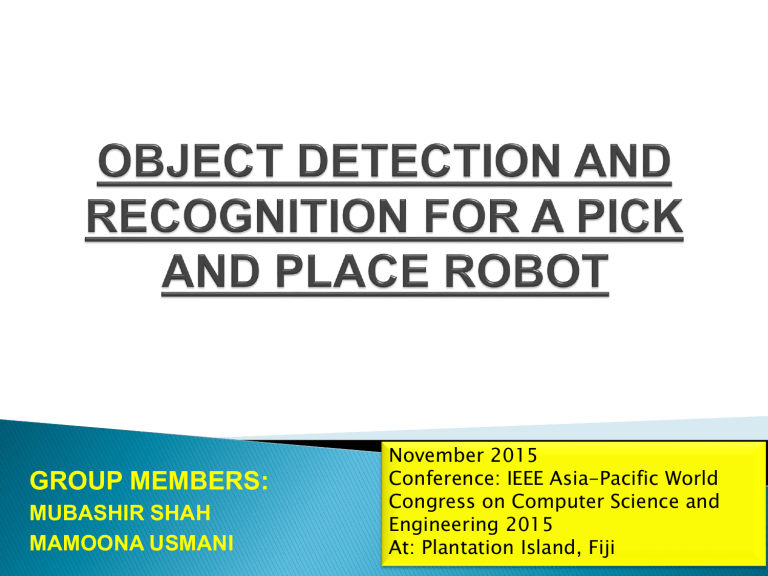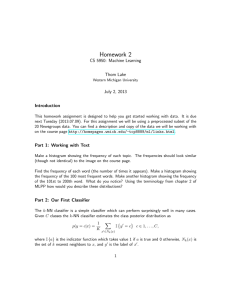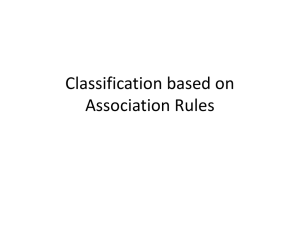
GROUP MEMBERS: MUBASHIR SHAH MAMOONA USMANI November 2015 Conference: IEEE Asia-Pacific World Congress on Computer Science and Engineering 2015 At: Plantation Island, Fiji Introduction Conceptual Framework of Entire System Feature Extraction The ANN Classifier Location of Extracted Image Conclusion & Results Demo Object detection and recognition using vision sensors and its implementation on SCORBOT ER-4U (robotic arm platform) [9] which will be refurbished and utilized to sort electronic components such as resistors and capacitors for laboratory technicians robotic arm Object detection (IP) Algorithms require huge processing time for successful implementation The technique includes feature extraction algorithm followed by a classifier to recognize the objects under test Once the object is finalized the result would be the type of the object along with its coordinates Work done by previous researchers include: The work presented by T.P. Cabre et el, used of basic algorithms like image enhancement, noise reduction and a visual loop algorithm (based on trial and error approach) prior to applying image processing techniques IP algorithms developed to reduce response time and increase in the efficiency for the object recognition tasks. Employing a parallel programming approach called object surface reconstruction method, ten times faster. Communication of vision system (webcam) via USB and through MATLAB, the system is enabled to perceive environment via IP algorithms Usage of multi-stereo vision technique for the detection of 3D Object. Eliminating the background/ least req information, using opening and closing morphological techniques. Use of Viola-Jones IP method, one of the Robust Object detection algorithm basically developed for face detection, using cascaded architecture of the strong classifiers arranged in the order of complexity. Along with the classification part, the concept of Feature Extraction (FE) is also studied. Feature extraction via Contour matching , one of the best methods to detect objects. The trained shape is matched according to a probabilistically motivated distance measure which enhances the shape comparisons within the framework. Also noise reduction and other image optimization via segmentation and other IP techniques were used. Trainarp algorithm (derived from ANN). It also presents the method to migrate from the statistical approach to Artificial Neural Networks (ANN). The author has stated the efficiency as 95% and response time of 94ms. Object detected, cropped and resized according to classifier specification Training and validation of classifier result in data labels Required object along with its coordinates are computed Inverse kinematics results in pick & place Eliminating Hue & Saturation info while preserving intensity info Intends to minimize intra-class variance of black&white pixels. Pre-req for blob analysis. Use of rectangular SE to enlarge detected edges Pre-req for blob analysis, more clear & visible edges outlines Rectangular bounding boxes around detected objects; cropped & resized to 20x20 pixels & conversion to gray scale for classification Binary Image Dilation Edge Detection BLOB analysis Acquiring 312 images with different objects (bounding boxes around each) Dividing this datasets to 70% training & 30% test sets Labeling of training data Use of gradient descend back-propagation algorithm ◦ Decide ANN layers(3 layers; An input(400),a hidden(var) & output layer(as per no. of outputs) ◦ To train classifier, initialize weights and perform feedforward & update weights by back-propagation (20000 iterations) 2 Models of classifier 1. Converts cropped image of bounding box to gray-sale and resize as per classifier requirement 20 x 20 pixels 2. Cropped image is placed at center of white back ground; only the dimension that exceeds 20 x 20 is resized ie in 35 x 18 only 35 will be resized Cross-validation of Classifier- 5 fold method used on both models 400 Input Layers 25 Hidden Layers 2 Output Layers Blob analysis resulted in centroid points (xc,yc)-Known Conversion factor to obtain cm values from pixels Xc,yc Centroid values treated as end effectors posn Inverse Kinematics will be used for pick and place operation Orignal Image Grey Scale Image Edge Detection Dilation BLOB Analysis Binary Image Image Filling Feature Extraction Accuracy The feature extraction algorithm was tested using a separate set of test data and its accuracy was 83.6443%. Classifier Accuracy . Final Results is the table of 32 scenes which altogether has a total of 448 objects inclusive of both capacitor and non-capacitor images. RESULTS FROM THE PAPER The accuracy yielded by feature extraction is 83.6443% and the classifier accuracy is 99.33% (upon Cross-validation) The best model classifier has an input layer consists of 400 neurons, 25 hidden neurons and 2 output neurons




